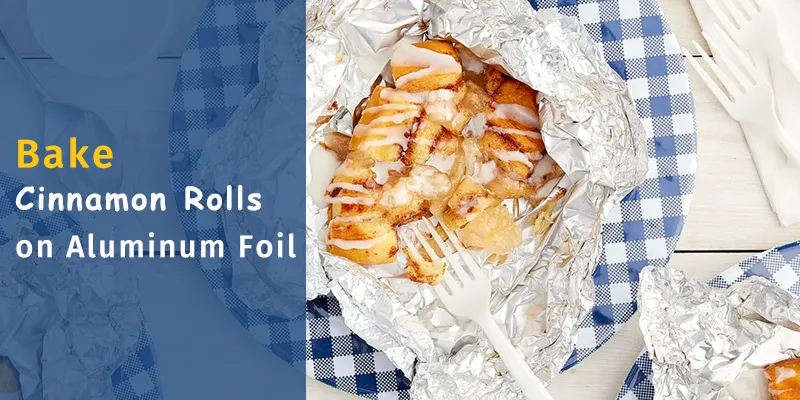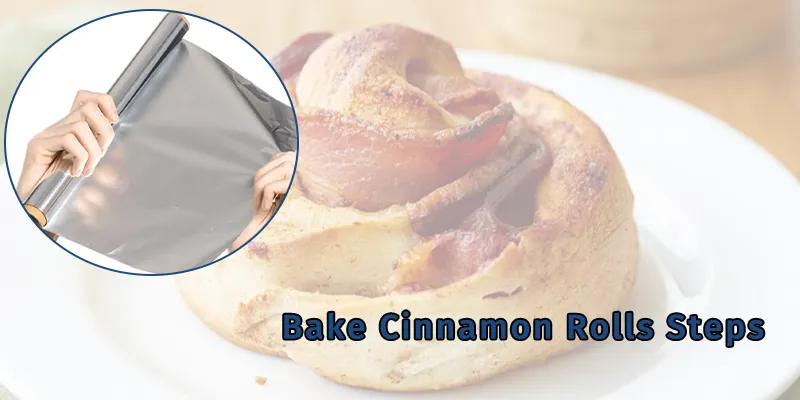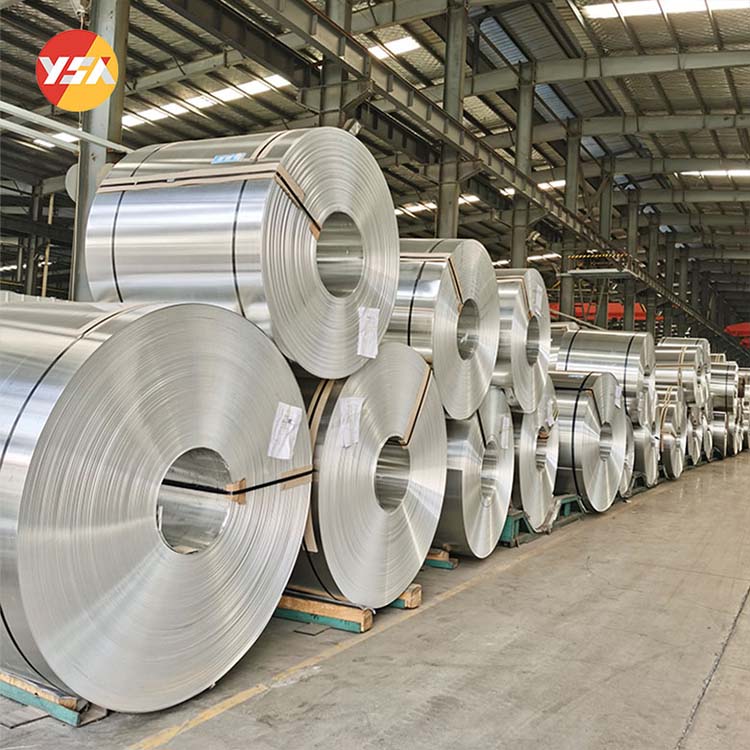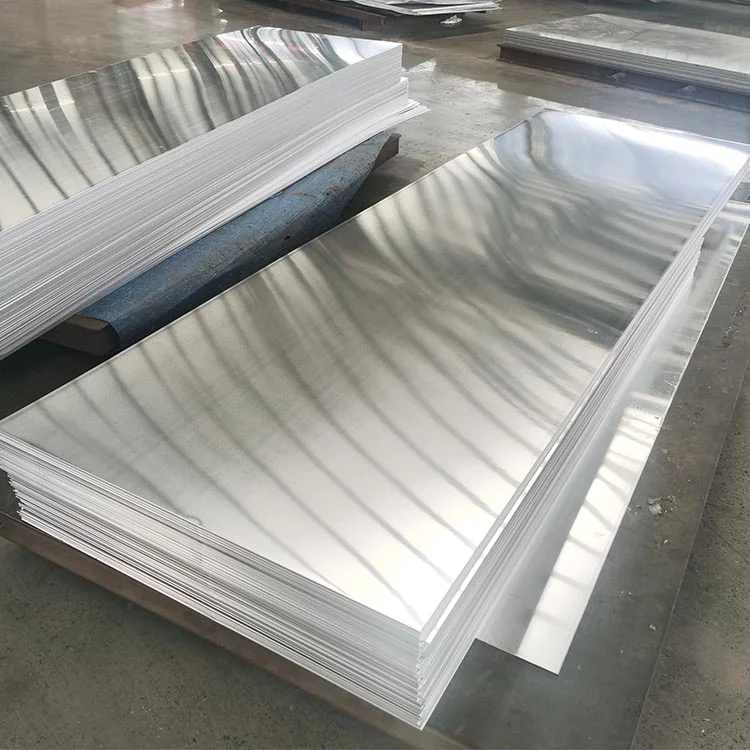If you love freshly baked cinnamon rolls but don’t want to deal with stubborn cleanup, you might wonder, can I bake cinnamon rolls on aluminum foil? In this comprehensive guide, we’ll explore the pros, cons, and best practices for using aluminum foil to bake perfect cinnamon rolls every time. We’ll also compare it to alternatives like parchment paper and silicone mats, so you can choose the best option for your kitchen.

Is It Safe To Bake Cinnamon Rolls On Aluminum Foil?
Aluminum foil is completely safe for baking cinnamon rolls. Here are some conderations:
Temperature Limits
- Aluminum foil can withstand oven temperatures up to 500°F (260°C), which is higher than most cinnamon roll recipes require.
- Avoid direct exposure to broiling flames, as extreme heat can weaken or warp the foil.
Sticking Issues
Unlike parchment paper, which has a non-stick coating, aluminum foil can stick to dough if not prepared correctly.
Aluminum Leaching Concerns
- Studies suggest that acidic foods (like citrus or tomato-based dishes) can cause slight aluminum leaching.
- Cinnamon rolls are not acidic, so this is generally not a concern.
Aluminum foil is safe for baking cinnamon rolls but requires prevention of sticking.
How To Bake Cinnamon Rolls?

Step 1: Prepare Your Baking Pan
Line your pan with heavy-duty aluminum foil for durability.
Grease the foil generously with butter, cooking spray, or oil to prevent sticking.
Step 2: Arrange the Rolls
Place cinnamon rolls 1–2 inches apart on the foil-lined pan. This allows room for rising.
Step 3: Bake as Directed
Follow your recipe’s temperature and time instructions. Most cinnamon rolls bake at 350°F–375°F (175°C–190°C) for 15–25 minutes.
Step 4: Cool and Remove
Let rolls cool for 5 minutes before lifting them off the foil with a spatula. If they stick, gently slide a knife underneath.
Aluminum Foil vs. Parchment Paper
The biggest concern with aluminum foil is sticking. Let’s compare:
| Factor | Feuille d'aluminium | Parchment Paper |
|---|---|---|
| Non-Stick Performance | Requires greasing; may stick if undersprayed | Naturally non-stick; minimal greasing |
| Heat Conductivity | Excellent | Good, but slightly less even |
| Impact sur l'environnement | Recyclable (if clean) | Compostable (unbleached varieties) |
| Cost | Affordable | Slightly more expensive |
Parchment paper is safer for sticky doughs, but foil works well if greased properly.
Tips to Prevent Cinnamon Rolls from Sticking to Aluminum Foil
- Use Heavy-Duty Foil: Thicker foil resists tearing and holds shape better.
- Grease Generously: Apply butter or oil to every inch of the foil’s surface.
- Add a Dusting of Flour: Sprinkle flour over greased foil for extra insurance.
- Avoid Sugar Overload: Excess caramelized sugar can glue rolls to foil.
- Cool Before Removing: Let rolls firm up slightly to reduce breakage.
- Use a Flexible Spatula: Slide it under rolls gently to preserve their shape.
Can Aluminum Foil Affect the Taste or Texture of Cinnamon Rolls
Potential Drawbacks of Baking with Foil
- Over-Browning: Aluminum foil reflects heat, which may cause faster browning on the bottom. Monitor baking time closely.
- Acidic Reactions: While rare, acidic ingredients (e.g., citrus glaze) can react with foil. Use parchment for such recipes.
- Crinkled Edges: Foil’s wrinkles might create uneven surfaces, leading to misshapen rolls.
Place a baking sheet under the foil-lined pan to diffuse heat and reduce over-browning.
FAQ
- Is aluminum foil safe for baking?
Yes, aluminum foil is FDA-approved for baking. However, avoid using it with highly acidic foods (e.g., tomato-based sauces) to prevent metallic leaching. - Can I reuse aluminum foil for baking?
Reusing foil is not recommended for hygiene reasons, especially after baking sticky foods like cinnamon rolls. - Should I cover cinnamon rolls with foil while baking?
Tent foil over rolls if the tops brown too quickly. This prevents burning while allowing the centers to cook through. - What’s the best alternative to aluminum foil?
Parchment paper or silicone baking mats are excellent non-stick alternatives.
7 Tricks for Cinnamon Rolls on Aluminum Foil
Baking cinnamon rolls on aluminum foil can yield delicious results, but it requires a few clever tricks to avoid sticking, uneven baking, or burnt edges. Whether you’re out of parchment paper or baking with foil, these tricks guarantee golden, gooey cinnamon rolls every time.
Use Heavy-Duty Aluminum Foil
Regular foil can tear under sticky dough or caramelized sugar. Heavy-duty foil is thicker, sturdier, and better at withstanding high heat. For safety, layer two sheets of heavy-duty foil to prevent leaks or rips.
Grease the Foil Enough
Brush melted butter, coconut oil, or non-stick spray (like Pam) evenly over the foil. Don’t skip the edges! Sprinkle a light dusting of flour or cornstarch over the greased foil for a non-stick surface.
Preheat Foil-Lined Pan
Place your foil-lined baking sheet in the oven as it preheats. A hot pan jumpstarts baking, creating crispier bottoms and preventing dough from adhering. Use oven mitts to arrange rolls on the hot pan quickly.
Space Rolls Properly
Leave 1.5–2 inches between rolls on the foil. Crowding traps steam, leading to soggy edges and uneven rise. For pull-apart rolls, place them closer (1 inch apart), but grease the foil thoroughly to avoid merging.
Tent with Foil Mid-Bake
If the tops brown too fast, loosely tent a foil sheet over the rolls at the 10-minute mark. Until it turns soft, pillowy tops with fully baked centers.
Cool Before Removing
Let rolls cool for 5–7 minutes on the foil. This allows caramelized sugar to firm up, reducing breakage. Slide a flexible silicone spatula or butter knife under each roll to lift gently.
Adjust Baking Time/Temperature
Aluminum foil reflects heat, speeding up browning. Reduce oven temp by 10°F (5°C) or check for doneness 2–3 minutes early.
Test: Rolls are done when the internal temperature reaches 190°F (88°C) or the centers spring back when tapped.


